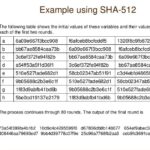In the expansive universe of data integrity, the hash value stands as a digital sentinel, a compact representation of any arbitrary input. But how long is a hash value? This simple question unfurls into a tapestry of complexities, intertwining security, efficiency, and a meticulous dance of mathematics and computer science. Understanding hash values and their lengths isn’t just a technicality; it’s a crucial tenet for data security and digital forensics.
To navigate this topic, one must first appreciate the nature of hash functions. Hash functions condense input—be it text, files, or pictures—into a fixed-size string of characters. This transformation is akin to distilling a grand novel into a single poignant quote. Just as that quote captures the essence of the narrative, a hash value encapsulates the inherent information of its source. The results are often rendered in hexadecimal format, a string of numbers and letters, yet they bear no resemblance to the original input.
When discussing the length of a hash value, one typically refers to the size of the output generated by these functions. Popular hash functions like MD5 produce a 128-bit hash, while SHA-1 produces a 160-bit hash. More recently, SHA-256, which is part of the SHA-2 family, generates a more robust 256-bit hash. This increase in bit length enhances the difficulty for adversaries attempting to reverse-engineer the input from the hash—a process known as pre-image resistance. It is an escrow against malicious intents, rendering it nearly impossible for unauthorized parties to discern the input solely from its hash value.
But why should one care about the length of these outputs? The answer lies in the delicate balance between security and performance. Consider this: in an age brimming with cyber threats, the need for secure data handling has never been more pronounced. The length of a hash value directly correlates with its security; longer hashes exponentially increase the computational effort required for an attacker to successfully execute a brute force attack, which attempts countless permutations in hopes of landing on the original input.
Herein lies a paradox. Hash functions that produce shorter outputs, like the aforementioned MD5, still see usage due to their speed and efficiency. However, in neglecting the robust security of longer hashes, users unwittingly open Pandora’s box, exposing their data to vulnerabilities. The allure of speed must be weighed against the specter of potential breaches. In this digital age, choosing the proper hash function is akin to selecting a lock for one’s front door; you wouldn’t opt for a flimsy padlock in a neighborhood rife with burglaries.
Additionally, the phenomenon known as a hash collision—where two distinct inputs result in the same hash value—underscores the importance of length. While unlikely, collisions become more feasible with shorter hashes as they encompass fewer unique outputs. For instance, an MD5 hash has a finite output space, which can lead to instances where two different files yield identical hashes. This occurrence can be easily exploited by malicious actors, further compromising data integrity.
The philosophy behind hash lengths extends beyond mere security concerns; it also influences data storage and retrieval systems in surprisingly nuanced ways. In databases, for example, a shorter hash can facilitate speedier access and lower resource consumption, yet comes packaged with the aforementioned risks. Conversely, deploying longer hashes, though they may require more storage space, imbues the system with a critical layer of security—a shield against unauthorized access and data tampering.
In the realm of cryptocurrencies, the length of a hash value serves a similarly pivotal function. Bitcoin, for instance, employs the SHA-256 algorithm, affirming its commitment to robust security. The amalgamation of longest hash outputs with mining processes creates a labyrinthine puzzle that miners must solve, where the length functions as a barrier against the quick and illicit reproduction of transactions. The interplay between hash length and mining difficulty is a testament to both art and science in cryptography, highlighting the unique appeal of this digital ecosystem.
In conclusion, the length of a hash value is not merely a technical specification; it embodies the essence of our digital existence. It serves as a bulwark against the chaos that pervades cyberspace, ushering forth security in a landscape marked by vulnerabilities. As one navigates the regulated pathways of data representation and security, the implications of hash lengths resonate deeply, instilling a profound appreciation for the seemingly simple yet intricately woven world of hash values.
In a world where data is currency, the hash value stands not just as an arcane sequence of characters but as the invisible gatekeeper safeguarding the sanctity of information. Understanding its length—and what that entails—reminds us to remain vigilant. In the end, every hash tells a story, and it is through the lengths of these values that we glean the narratives of safety, integrity, and resilience in an otherwise volatile digital sphere.








Leave a Comment